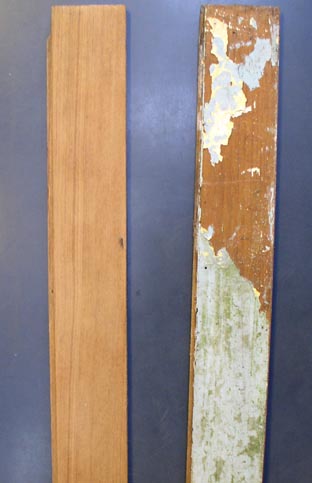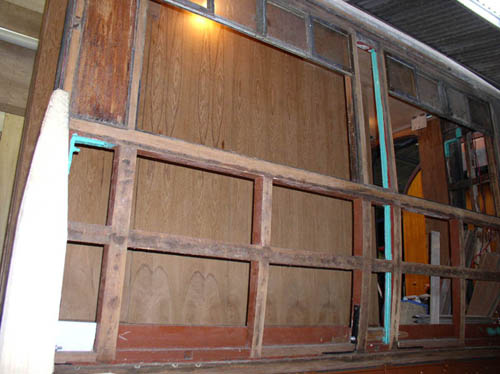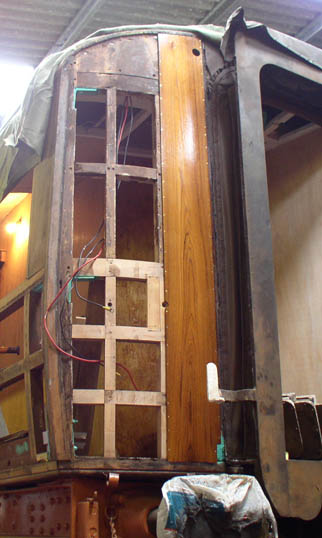
The inside panels of the coach ends where the framing has been replaced needed to be made up. We were originally envisaging using routered panels of teak faced ply made to look like the original tongue and groove vertical planking. However, since the discovery of the 5/8 TK at Crawford, quite a lot of tongue and groove boarding has been recovered from that coach. As you can see from the picture, the mouldy looking plank on the right ("before") cleans up a real treat as the beautiful looking specimen on the left. Of course, many of the tongues are broken and bits are missing off many of the grooves, but it is amazing what you can do with some glue and masking tape to make them "like new".

The Crawford coach also yielded quite a few external panels which were mouldy, green, broken and split. However, after slicing them up to suitable size and running them through the thicknesser on both sides, lovely pieces of teak to make skirting and door surrounds etc were obtained.

Panelling has now been added to the corridor side of the kitchen partition. The sliding door has also been panelled and a pelmet and doorstop manufactured and put in place. The door arch has been secured in place between the corridor and the saloon and a similar item made for the saloon / vestibule partition at the other end of the coach.

The saloon doors for both ends are now being manufactured (June/July 2004). These are made from a sandwich of 2 thicknesses of plywood with teak veneer ply glued on to one side. The non-hinge side of the door has to be bevelled, the teak faced side being the smaller at the vestible end of the saloon as the door opens into the saloon at that end. At the corridor end of the saloon, the door opens into the corridor, so the rexine side of the door is the smaller. The hinge side and the curved top of the door are left square. A 10mm deep groove is routered out of the edge of the door so the rexine can be glued into place. The groove is then filled with velvet strip covered 10mm wide wood strips to complete it and provide a softer door closing action.
The handles for the saloon doors have been obtained (from the LNERCA) in unchromed form, so still some money to spend there! The handles were brought to Bo'ness at the same time as the remainder of the teak boards and mouldings needed to cover the exterior of the vehicle. No sooner did the teak arrive than it was felt a psychological imperative to get some of it on to the coach, so the first panel for the NW corner was cut, shaped and drilled, then screwed in place with lots of 1" x 6 brass screws whose heads will be covered by the half-round mouldings. The tank filler pipe fits through the hole near the top of the panel, the plumbing of which has been done by Mr R.C.Nelson. Several coats of varnish have been applied to the panel a) to protect it, and b) because varnishing with the filler pipe in place is difficult.
The roof canvas is visible in this photograph. The roof canvas has been stored folded up in
a bundle since 1970 something, so we spread it out on the roof to see if the creases would come out. Surprisingly
there were no holes in the canvas and no rotten bits. It didn't look too hopeful that the creases would disappear.
So we decided to fibreglass the roof instead.